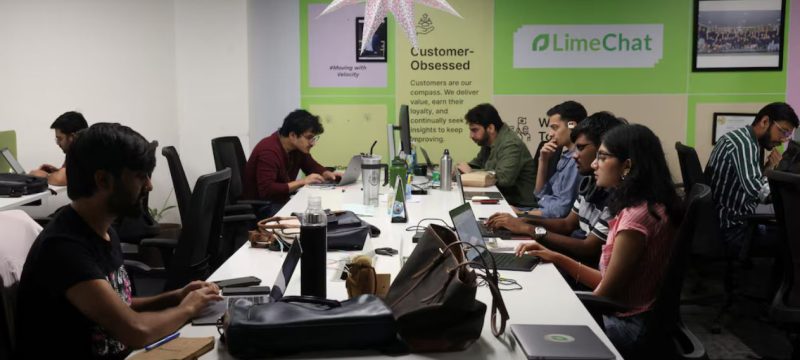India’s New AI Revolution
Inside a buzzing startup office in Bengaluru, developers at LimeChat are training artificial-intelligence chatbots that can converse and message like humans. Their mission is ambitious — to make traditional customer-service jobs nearly obsolete.
LimeChat’s generative AI agents help companies handle customer queries with minimal human involvement, allowing them to reduce their workforce by up to 80%.
“Once you hire a LimeChat agent, you never have to hire again,”
said Nikhil Gupta, the 28-year-old co-founder of the company.
This statement captures the seismic shift underway in India’s $283 billion IT and outsourcing industry, where AI-powered automation is transforming customer care, technical support, and data services once dominated by human workers.
From Global Back Office to AI Powerhouse
For decades, India’s competitive edge lay in its low labor costs and English-speaking workforce, making it the world’s back office. Millions of graduates found employment in call centers, customer support, and back-office operations.
Today, however, that advantage is eroding. Artificial intelligence systems are taking over routine, repetitive work, forcing both businesses and employees to adapt.
Despite the looming threat of job losses, India’s government remains optimistic. Prime Minister Narendra Modi has emphasized that while technology changes the nature of work, it also creates new opportunities.
“Work does not disappear due to technology. Its nature changes,”
Modi said earlier this year.
Yet, not everyone shares that confidence.
Former Indian government official Santosh Mehrotra criticized the lack of a national strategy to assess AI’s impact on employment, warning:
“There’s no game plan.”
Job Losses and New Realities
India’s business process management (BPM) sector — which employs 1.65 million workers — is already showing signs of stress. Hiring has slowed dramatically due to automation and digitalization.
According to TeamLease Digital, net headcount growth in the sector fell from 177,000 in 2021–22 to fewer than 17,000 in each of the past two years.
Workers are feeling the pressure.
Megha S., a 32-year-old from Bengaluru, lost her $10,000-a-year job last month after her company began using AI to monitor sales calls.
“I was told I am the first one who has been replaced by AI,” she said quietly. “I haven’t told my parents yet.”
Experts warn that Megha’s story could become increasingly common as companies seek to streamline costs and improve efficiency.
A High-Stakes Gamble for India
Analysts caution that India’s gamble on rapid AI adoption could have far-reaching economic consequences.
A report by Jefferies Investment Bank predicts that AI could cut call-center revenues by 50% and other back-office revenues by 35% over the next five years.
Adding to the challenge are international pressures:
- The U.S. proposal for a 25% tax on companies outsourcing work overseas.
- President Trump’s $100,000 fee on new H-1B visas — a move that hits Indian IT firms hardest.
Despite these headwinds, some industry veterans believe AI presents a new opportunity.
Pramod Bhasin, who established India’s first call center in the 1990s and later founded Genpact, argues that India can transform itself from the “world’s back office” to the “world’s AI factory”, training engineers to develop and deploy AI systems globally.
The AI Boom: LimeChat and Beyond
LimeChat’s Rapid Rise
At LimeChat’s Bengaluru office, developers and engineers are automating thousands of customer-service tasks. Gupta says the company’s bots already handle 70% of customer complaints, with a goal of reaching 90–95% automation within a year.
- Cost: ₹100,000 ($1,130) per month — automating the work of 15 agents.
- Revenue Growth: From $79,000 in 2022 to $1.5 million in 2024.
- Partnerships: Integrated with Microsoft Azure for advanced AI modeling.
- Clients: Include Kapiva (ayurvedic products) and Mamaearth (personal care brand).
For brands like Mamaearth, scalability is key.
“Providing good customer support is make or break for us,” said Vipul Maheshwari, Head of Product and Analytics. “But can we infinitely scale our customer support team? Absolutely not.”
Haptik: Reliance’s AI Bet
LimeChat’s biggest rival is Haptik, acquired by Reliance Industries in 2019.
It offers AI agents that deliver human-like interactions at a cost of just $120 per bot, reducing customer-support costs by up to 30%.
Revenue jumped from under $1 million in 2020 to nearly $18 million in 2024.
In a recent webinar, Haptik asked provocatively:
“What if you had a full-time employee who never sleeps and costs just 10,000 rupees?”
Automation in Action: The Media Ant and ‘Neha’
Advertising firm The Media Ant has embraced automation aggressively, cutting 40% of its workforce in one year.
Founder Samir Chaudhary said:
- 15 salespeople were replaced by automated email bots.
- A six-member call team was replaced by a voice AI agent named Neha, who speaks fluent Indian-accented English.
During a test, Neha confidently handled inquiries about YouTube advertising and ended the call with a polite:
“I will email you the details … have a great day.”
Chaudhary joked, “Ask her out for a coffee and she’ll laugh it off.”
While humorous, the remark underscores the growing realism of AI-driven human interaction.
Consumers Still Crave Human Touch
Despite AI’s efficiency, consumers remain divided.
A 2024 EY survey of 1,000 Indian consumers found that 62% made purchases influenced by AI recommendations — twice the global average.
However, 78% said they prefer human support when using online platforms, showing that trust and empathy still matter deeply in customer service.
Even advanced bots like LimeChat’s occasionally stumble. When asked for evidence supporting a client’s claim that “one million medical professionals trust its products,” a bot replied:
“I’m sorry, I don’t have enough information to answer your question.”
India’s Workforce Shifts from Java to AI
The AI revolution is reshaping education, too.
In Hyderabad’s Ameerpet district, once known for Java and Microsoft Office training, institutes now advertise AI and data science courses.
At Quality Thought, a nine-month AI data science and prompt engineering program costs $1,360 — more than double traditional IT course fees.
“Recruiters are asking for students with basic AI skills,” said instructor Priyanka Kandulapati. “We’re adjusting our programs to meet demand.”
The Road Ahead: Opportunity or Upheaval?
India stands at a crossroads.
AI offers immense promise — higher productivity, innovation, and potential global leadership in intelligent automation. But it also threatens millions of entry-level jobs that helped lift families into the middle class.
Venture capitalist Vinod Khosla, co-founder of Sun Microsystems, offered a sobering prediction:
“All IT services will be replaced in the next five years. It’s going to be pretty chaotic.”
As India races ahead in AI, the world watches closely. The country’s experience could become a test case — proving either that embracing automation can fuel inclusive growth, or that unchecked disruption can deepen inequality in the digital age.
Conclusion
AI is redefining India’s role in the global technology landscape.
What began as a revolution in call centers is now evolving into a broader transformation of how people work, learn, and interact.
Whether this change will create new prosperity or a new wave of displacement depends on how India balances innovation with inclusion — and how swiftly its workforce can transition from answering calls to coding the future.
In other news also read about Google AI: $15 Billion Data Centre to Boost India’s Tech Growth









